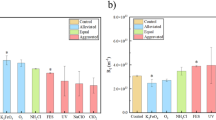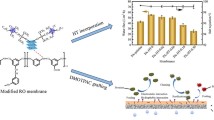Abstract
The model cationic molecule prodigiosin interacted with a polyamide/polysulfone composite reverse osmosis (RO) membrane, resulting in a reduction of the membrane permeation rate. Prodigiosin is an antibacterial agent produced by Serratia marcescens that is frequently isolated from activated sludge of domestic or industrial wastewater. Such molecules respectively secreted or leaked from live or dead cells are thought to affect membrane biofouling. In this study, a cell suspension containing prodigiosin-producing S. marcescens AS-1 wild-type or the non-producing AS-1ΔspnI strain was fed to the thin RO membrane to determine the occlusion ratio on the membrane. Cationic prodigiosin enhanced membrane biofouling by clogging the pores and enhanced the accumulation of the cake layer. The effects remarkably recovered the occlusion ratio after removing the cake layer by feeding with water. After temporary pressure relief, the occlusion ratios for AS-1 and AS-1ΔspnI were recovered to stable levels from approximately 70 to 49% and 23%, respectively. Zetapotential analysis supported the neutralization effects leading to the accumulation of bacterial cells under applied high pressure for RO membrane permeation.
Similar content being viewed by others
References
Meng, F., S.-R. Chae, A. Drews, M. Kraume, H. S. Shin, and F. Yang (2009) Recent advances in membrane bioreactors (MBRs): Membrane fouling and membrane material. Water Res. 43: 1489–1512.
Tam, L. S., T. W. Tang, G. N. Lau, K. R. Sharma, and G. H. Chen (2006) A pilot study for wastewater reclamation and reuse with MBR/RO and MF/RO systems. Desalination 202: 106–113.
Tang, C. Y., T. H. Chong, and A. G. Fane (2011) Colloidal interactions and fouling of NF and RO membranes: A review. Adv. Colloid Interface Sci. 164: 126–143.
Chang, I. S., S. O. Bag, and C. H. Lee (2001) Effects of membrane fouling on solute rejection during membrane filtration of activated sludge. Proc. Biochem. 36: 855–860.
Maqbool, T., V. L. Quang, J. Cho, and J. Hur (2016) Characterizing fluorescent dissolved organic matter in a membrane bioreactor via excitation–emission matrix combined with parallel factor analysis. Biores. Technol. 209: 31–39.
Choi, J., E. S. Kim, and Y. Ahn (2017) Microbial community analysis of bulk sludge/cake layers and biofouling-causing microbial consortia in a full-scale aerobic membrane bioreactor. Biores. Technol. 227: 133–141.
Hörsch, P., A. Gorenflo, C. Fuder, A. Deleage, and F. H. Frimmel (2005) Biofouling of ultra-and nanofiltration membranes for drinking water treatment characterized by fluorescence in situ hybridization (FISH). Desalination 172: 41–52.
Barnes, R. J., R. R. Bandi, F. Chua, J. H. Low, T. Aung, N. Barraud, A. G. Fane, S. Kjelleberg, and S. A. Rice (2014) The roles of Pseudomonas aeruginosa extracellular polysaccharides in biofouling of reverse osmosis membranes and nitric oxide induced dispersal. J. Membrane Sci. 466: 161–172.
Pasmore, M., P. Todd, S. Smith, D. Baker, J. Silverstein, D. Coons, and C. N. Bowman (2001) Effects of ultrafiltration membrane surface properties on Pseudomonas aeruginosa biofilm initiation for the purpose of reducing biofouling. J. Membrane Sci. 194: 15–32.
Chung, Y. C., Y. -P. Su, C. -C. Chen, G. Jia, H. -L. Wang, J. C. G. Wu, and J. -G. Lin (2004) Relationship between antibacterial activity of chitosan and surface characteristics of cell wall. Acta Pharmacol. Sin. 25: 932–936.
Park, H., S. G. Lee, T. K. Kim, S. J. Han, and J. H. Yim (2012) Selection of extraction solvent and temperature effect on stability of the algicidal agent prodigiosin. Biotechnol. Bioproc. Eng. 17: 1232–1237.
Berger, M., A. Neumann, S. Schulz, M. Simon, and T. Brinkhoff (2011) Tropodithietic acid production in Phaeobacter gallaeciensis is regulated by N-acyl homoserine lactone-mediated quorum sensing. J. Bacteriol. 193: 6576–6585.
Nasuno, E., Y. Abe, K. Iimura, M. Ohno, T. Okuda, W. Nishijima, and N. Kato (2017) Isolation of biofilm-forming bacteria from the secondary effluent of wastewater treatment plants and its ability to produce N-acylhomoserine lactone as quorum sensing signal. Appl. Mech. Mater. 863: 135–140.
Ohno, M., C. Manalo, L. Rossetto, T. Okuda, S. Nakai, and W. Nishijima (2016) Effect of coexisting metal ions on the degradation of polyamide reverse osmosis membrane by hypochlorite treatment. Desalination 381: 126–134.
Morohoshi, T., T. Shiono, K. Takidouchi, M. Kato, N. Kato, J. Kato, and T. Ikeda (2007) Inhibition of quorum sensing in Serratia marcescens AS-1 by synthetic analogs of N-acylhomoserine lactone. Appl. Environ. Microbiol. 73: 6339–6344.
Slater, H., M. Crow, L. Everson, and G. P. C. Salmond (2003) Phosphate availability regulates biosynthesis of two antibiotics, prodigiosin and carbapenem, in Serratia via both quorum-sensing-dependent and -independent pathways. Mol. Microbiol. 47: 303–320.
Wang, Z., Z. Wu, X. Yin, and L. Tian (2008) Membrane fouling in a submerged membrane bioreactor (MBR) under sub-critical flux operation: membrane foulant and gel layer characterization. J. Membr. Sci. 325: 238–244.
Chu, H. P. and X. -Y. Li (2005) Membrane fouling in a membrane bioreactor (MBR): Sludge cake formation and fouling characteristics. Biotech. Bioeng. 90: 323–331.
Ma, D., B. Gao, S. Sun, Y. Wang, Q. Yue, and Q. Li (2013) Effects of dissolved organic matter size fractions on trihalomethanes formation in MBR effluents during chlorine disinfection. Biores. Technol. 136: 535–541.
Kim, H. C. and B. A. Dempsey (2013) Membrane fouling due to alginate, SMP, EfOM, humic acid, and NOM. J. Membrane Sci. 428: 190–197.
Geyik, A. G., B. Kiliç, and F. Çeçen (2016) Extracellular polymeric substances (EPS) and surface properties of activated sludges: Effect of organic carbon sources. Environ. Sci. Pollut. Res. 23: 1653–1663.
Author information
Authors and Affiliations
Corresponding author
Rights and permissions
About this article
Cite this article
Yamanouchi, S., Nasuno, E., Ohno, M. et al. Enhancement effects of cationic contaminants from bacteria on cake layer formation and biofouling on an RO membrane. Biotechnol Bioproc E 22, 281–286 (2017). https://doi.org/10.1007/s12257-017-0093-4
Received:
Revised:
Accepted:
Published:
Issue Date:
DOI: https://doi.org/10.1007/s12257-017-0093-4




